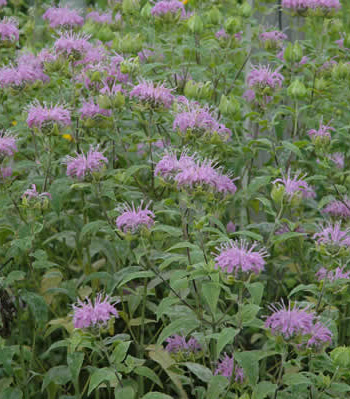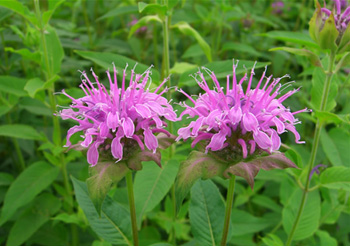Contents:
Common Names | Parts Usually Used | Plant(s) & Culture | Where Found | Medicinal Properties
Legends, Myths and Stories | Uses | Formulas or Dosages | Bibliography
Scientific Names

- Monarda didyma L.
- Larmiaceae
- Labiatae
- Mint family
Common Names
- American bee balm
- Beebalm
- Gold melissa
- Indian nettle
- Oswego tea
- Red bergamot
- Scarlet monarda
Parts Usually Used
Leaves
Back to Top
Description of Plant(s) and Culture

Bergamot is an American perennial; it is
Other varieties: Orange mint
Wild bergamot or Purple
Lemon bergamot or lemon mint
Back to Top
Where Found
Native of the Oswego, New York area; found in thickets, fields, on streams banks and cultivated in herb gardens. New York to Georgia; Tennessee to Michigan.
Back to Top
Medicinal Properties
Stimulant, carminative, rubefacient
Back to Top
Legends, Myths and Stories
This plant is entirely different and hardier than Melissa. It is a beautiful scarlet flowering native American mint. The foliage has a perfume fragrance. The flowers are so popular with bees that the plant deserves the name American bee balm.
Bergamot or bee balm is a part of American history; it is a source of tea which was a popular substitute for the imported variety amongst the mid-Atlantic patriots in the wake of the Boston Tea Party. That period was probably the best in bergamot’s history, though it retains its mystique, thanks to a striking appearance and the richly American
The name Oswego tea came from the town, Oswego, New York? More likely both the town and the tea acquired the name Oswego from the Native Americans inhabiting the area, who had it first. The Native Americans passed their knowledge of the plant to the colonists, and one, a John Bartram of Philadelphia, reportedly sent seeds to England in the
Among the foremost growers of this herb in the United States were the Shakers, who had a settlement near Oswego, New York. The Shakers were among America’s great herbalists; they valued bergamot not only for tea and culinary uses, but for its medicinal virtues. The leaves can be used to flavor apple jelly, fruit cups, and salads.
The entire plant emits a strong fragrance similar to citrus, but most like that of the tropical tree, orange bergamot, hence the nickname bergamot. The scent is suitable for use in potpourris and other scented mixtures. The bright red flowers attract bees, hummingbirds, and butterflies and make striking, long-lasting cut blooms. The blossoms provide the flavoring for the famous Earl Grey tea. The flowers are also edible.
The hills around Pittsfield, Massachusetts are rife with this plant, wild and domestic.
Back to Top
Uses
An infusion is good for colds, coughs, nausea, and sore throats. Native Americans used leaf tea for colic, gas, colds, fever, stomachaches, nosebleeds, insomnia, heart trouble, measles, and to induce sweating. Poultice used for headaches. Historically, physicians used leaf tea to expel worms and gas.
Back to Top
Formulas or Dosages
The best quality tea material is achieved if the leaves are stripped off the square, hollow stems and dried in warm shade within
Back to Top
Bibliography
![]() Eastern/Central Medicinal Plants
Eastern/Central Medicinal Plants, by Steven Foster and James A. Duke., Houghton Mifflin Company, 215 Park Avenue South, New York, NY 10000
![]() The Herbalist Almanac
The Herbalist Almanac, by Clarence Meyer, Meyerbooks, publisher, PO Box 427, Glenwood, Illinois 60425, copyright 1988, fifth printing, 1994
![]() Country Home Book of Herbs
Country Home Book of Herbs, Meredith Books, Editorial Dept. RW240, 1716 Locust Street, Des Moines, IA 50309-3023, copyright 1994
Herbal Gardening, compiled by The Robison York State Herb Garden, Cornell Plantations, Matthaei Botanical Gardens of the University of Michigan, University of California Botanical Garden, Berkeley., Pantheon Books, Knopf Publishing Group, New York, 1994, first edition
 Old Ways Rediscovered
Old Ways Rediscovered, by Clarence Meyer, Meyerbooks, publisher, PO Box 427, Glenwood, Illinois 60425, published from 1954, print 1988
![]() Webster’s New World Dictionary
Webster’s New World Dictionary, Third College Edition, Victoria Neufeldt, Editor in Chief, New World Dictionaries: A Division of Simon & Schuster, Inc., 15 Columbus Circle, New York, NY 10023
 The Rodale Herb Book: How to Use, Grow, and Buy Nature’s Miracle Plants (An Organic gardening and farming book)
The Rodale Herb Book: How to Use, Grow, and Buy Nature’s Miracle Plants (An Organic gardening and farming book), edited by William H. Hylton, Rodale Press, Inc. Emmaus, PA, 18049., 1974
